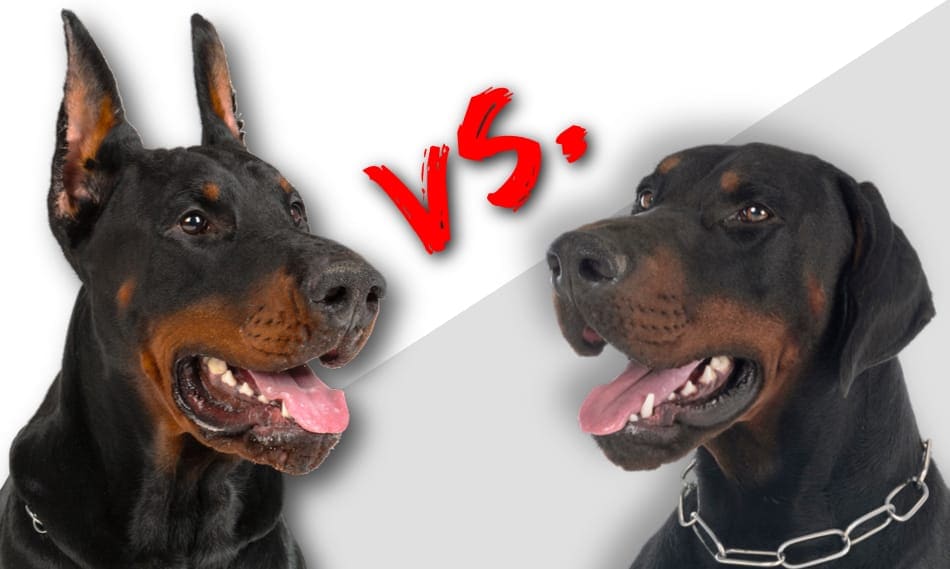When it comes to Doberman Pinschers, their cropped ears have often been a topic of discussion. Many people wonder why owners choose to crop their Doberman’s ears. The answer to that question lies in both the breed’s history and its appearance.
Cropping Doberman ears has been a longstanding tradition that dates back to the breed’s origins. Historically, it was believed that cropped ears gave the Doberman a more alert and intimidating look, which served their role as guard dogs. Additionally, cropped ears were thought to prevent injuries during work or combat. While this practice is now more controversial and less common, some breed enthusiasts and owners still choose to crop their Dobermans’ ears for aesthetic reasons. Despite the controversy, it’s important to remember that cosmetic decisions should always be made in the best interest of the dog’s well-being.
Many Doberman owners choose to crop their dog’s ears for several reasons. First, it can give them a more alert and imposing appearance. Cropped ears also help prevent ear infections by improving airflow. Additionally, show standards often require ear cropping. However, it’s important to note that ear cropping is a personal choice and not necessary for the dog’s health or well-being. If you decide to crop your Doberman’s ears, make sure to find a reputable veterinarian experienced in this procedure.

Why Are Doberman Ears Cropped?
Doberman Pinschers are known for their sleek and elegant appearance, and one distinguishing feature that sets them apart is their cropped ears. But why are Doberman ears often cropped? In this article, we will explore the history, rationale, and controversy surrounding this practice.
1. Historical Reasons
Cropping the ears of Doberman Pinschers has historical roots that can be traced back to their original purpose as working dogs. The breed was developed in the late 19th century by a German tax collector named Karl Friedrich Louis Dobermann. Dobermans were initially bred as guard dogs and to assist in tax collection, making their intimidating appearance an essential characteristic.
During those times, ear-cropping was a common practice among working dogs and served practical purposes. Cropping the ears made them less vulnerable to injuries during confrontations, especially while protecting their owners or handling challenging tasks. Additionally, it was believed that cropped ears enhanced their hearing abilities by allowing sound waves to enter the ear more easily.
Over time, the tradition of ear-cropping in Dobermans became ingrained in the breed’s history and aesthetic appeal, even as their role shifted from working dogs to beloved family pets.
2. Aesthetic and Breed Standard
Doberman Pinschers are known for their proud and alert stance. The cropped ears contribute to their distinct look and are considered an important part of the breed’s standard. According to the American Kennel Club (AKC) breed standard for Dobermans, the ears should be “set high on the head and carried erect.” The desired shape is described as “long and tapering smoothly to a point.”
By cropping the ears, breeders aim to achieve the ideal ear shape and carriage described in the breed standard. This helps maintain the consistency and aesthetic appeal of the Doberman Pinscher breed. Furthermore, the cropped ears can enhance the dog’s facial expression, emphasizing their alert and attentive nature.
3. Health and Practical Considerations
While the historical and aesthetic reasons play significant roles in the decision to crop a Doberman’s ears, there are also health and practical considerations to be aware of.
One practical aspect is that cropped ears may reduce the risk of ear infections and various ear-related problems. The shape and position of the cropped ears allow for better air circulation and prevent moisture buildup in the ear canal, which can be breeding grounds for bacteria and yeast.
However, it’s essential to note that proper ear care, including regular cleaning and check-ups, is crucial for any Doberman, regardless of whether their ears are cropped or left natural.
4. Controversy and Ethical Concerns
The practice of ear-cropping is not without controversy and has faced criticism from various animal welfare organizations and some veterinarians. The primary ethical concern revolves around the procedure itself, which involves the surgical removal or reshaping of the dog’s ears under anesthesia.
Opponents argue that ear-cropping is an unnecessary and potentially painful procedure that can result in complications, such as infection, scarring, or unwanted aesthetic outcomes. They believe that docking dogs’ ears for cosmetic purposes goes against the principle of minimizing unnecessary procedures that alter an animal’s natural appearance.
As a result of these ethical concerns, ear-cropping practices have been banned or restricted in several countries and regions.
5. Making an Informed Decision
If you are considering cropping your Doberman’s ears, it is crucial to consult with a qualified and experienced veterinarian who can provide the necessary information and guidance. They can explain the procedure, potential risks, and adequate aftercare to ensure the well-being of your pet.
Ultimately, the decision to crop a Doberman’s ears should involve careful consideration of various factors, including the dog’s health, breed standards, and ethical concerns. It is important to prioritize the health and welfare of your beloved pet above aesthetic preferences.
Should Doberman Ears Be Cropped?
Considering the historical significance, breed standards, aesthetic appeal, health considerations, and ethical concerns, the decision to crop a Doberman’s ears remains a personal choice for owners. It is important to weigh all the aspects and make an informed decision that aligns with the well-being and welfare of the dog.
Key Takeaways: Why Doberman Ears Are Cropped?
- Cropping Doberman ears is primarily done for cosmetic purposes.
- Cropping can also be done as a traditional practice to maintain their intimidating appearance.
- The procedure involves surgical removal of a portion of the ear to create an upright and pointed appearance.
- Ears are cropped at a young age, usually between 6-12 weeks old, to ensure proper healing and shaping.
- Cropping is a personal choice and not mandatory, as some countries have banned the practice due to ethical concerns.
Frequently Asked Questions
Here are some common questions and answers related to why Doberman ears are cropped.
1. What is the purpose of cropping Doberman ears?
The primary reason for cropping Doberman ears is purely cosmetic. The practice originated in historical times when Dobermans were used as guard dogs and in military roles. Cropping the ears was believed to enhance their appearance and make them look more intimidating. Today, ear cropping is more of a personal preference and a breed standard in some countries, primarily for show Dobermans.
It’s important to note that ear cropping is a controversial subject and is illegal or restricted in certain countries due to concerns over animal welfare.
2. At what age are Doberman ears typically cropped?
Doberman ears are usually cropped when the puppies are between 7 and 12 weeks old. The timing is essential because it allows the cartilage in the ears to be shaped and molded while still flexible. The earlier the cropping is done, the more control the veterinarian has over the desired ear shape and placement. However, it’s crucial to consult with a reputable veterinarian who is skilled and experienced in performing ear cropping procedures.
It’s important to note that the decision to crop a Doberman’s ears should be carefully considered and discussed with a veterinarian who can provide guidance based on the specific circumstances and local regulations.
3. Does cropping the ears affect a Doberman’s hearing?
Cropping the ears should not significantly impact a Doberman’s hearing ability. The procedure involves removing a portion of the ears’ outer edge and then taping them to maintain an upright position during the healing process. While the healing period may temporarily affect the dog’s ability to localize sound accurately, once the ears have healed, there should be no long-term impact on the Doberman’s hearing.
It’s important to note that the success of the ear cropping procedure and the overall well-being of the Doberman depend on proper care, follow-up visits with a veterinarian, and adherence to post-operative instructions.
4. Is ear cropping painful for Dobermans?
Ear cropping is a surgical procedure that requires the use of anesthesia. While the puppies may experience discomfort during the healing process, proper pain management techniques are employed to minimize pain and ensure the dog’s well-being. Veterinarians typically provide pain medication and prescribe post-operative care instructions to help alleviate any discomfort.
It’s crucial to choose a reputable veterinarian who prioritizes the dog’s welfare and uses appropriate pain management protocols to ensure the dog’s comfort throughout the entire process.
5. What are the risks and complications associated with ear cropping?
As with any surgical procedure, ear cropping carries certain risks and potential complications. Some possible risks include infection, excessive bleeding, poor wound healing, and adverse reactions to anesthesia or pain medications. Additionally, there is always a risk that the desired aesthetic outcome may not be achieved.
Proper pre-operative evaluations, sterile surgical techniques, and post-operative care are crucial to reducing these risks and complications. It’s important to work with a skilled and experienced veterinarian who can explain the potential risks and benefits and provide guidance in making an informed decision.

Cropped Ears vs. Natural Ears: Which is Better?
The practice of cropping Doberman ears is primarily done for cosmetic reasons, to conform to breed standards and enhance their appearance. It involves surgically removing a portion of the ear to achieve an erect and pointed shape.
However, ear cropping is a controversial topic, and many countries have banned or strongly discouraged the practice due to concerns about animal welfare. It is important to consider the potential pain, risk of complications, and ethical implications before deciding to crop a Doberman’s ears.
